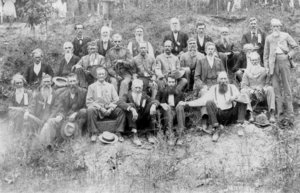The Amazing Evolution of the Statue of Liberty (12 Photos)
Did you know that the Statue of Liberty almost never got built, much less make it to New York City? The copper statue, a gift from the people of France to the people of the United States, was designed by French sculptor Frédéric Auguste Bartholdi and built by Gustave Eiffel. The statue was dedicated on October 28, 1886, nearly 20 years after the idea was hatched. These photos tell the amazing story of how it came to be...

After Bartholdi returned to Paris in 1877, he began working on the head of Lady Liberty. He was in constant fundraising mode at the same time, often selling tickets to visit the construction activity at his Gaget, Guthier, and Co. workshop. With the Americans now fully on board, he moved quickly and completed the head just in time to be displayed at the Paris World Fair in 1878, as seen above.

From start to finish, the Statue took around 15 years to complete, as the process was both complicated and one of the first large-scale projects of its kind to be undertaken in France. Here you see some of the more detailed work on the arm, which was completed just after the head.

As the statue began to scale toward the sky, designer and builder Gustave Eiffel (yes, that one!) was brought in to help build the scaffolding and trusses to support the statue and further construction. Here is a view of it about half-completed. As you'll see in the next photo, it soon began to tower above the Paris landscape.

In the following years, the scaffolding continued to move skyward until the head was added and each arm connected. Here is a view of the workshop (around 100 feet in the air!) in 1884, just before the statue was completed.

This late 1884 photo shows Lady Liberty towering over the Paris landscape just before she was disassembled and shipped to New York.

Meanwhile back in New York, designer Richard Morris Hunt was hard at work at the pedestal for the Statue, but construction would hit numerous speed bumps as fundraising always seemed to fall short. After the Governor of New York vetoed a bill to provide further funding in 1884 and Congress also couldn't pass a $100,000 grant, the entire project looked to be in jeopardy. Joseph Pulitzer, publisher of the New York World, conducted a successful $100,000 campaign that solicited small donations from people all across America. They ultimately raised $102,000 and 80% of the donations were in sums less than one dollar.

The statue remained intact in Paris until sufficient progress had been made on the pedestal in New York. By January 1885, the French had sufficient assurance, so the statue was disassembled and crated for its ocean voyage. Six months later, on June 17, 1885, the French steamer Isere, which had carried the statue across the ocean, arrived in the New York port. Historians note nearly two hundred thousand people lined the docks and hundreds of boats were put to sea to welcome the Isere.
This photo shows the scene in the harbor as the Isere arrived in port.

With confidence that the pedestal would ultimately be completed, workers began uncrating pieces of the Statue of Liberty on what was renamed Liberty Island. This late 1885 photo shows the two feet and crest of the torch just below the base of the pedestal.

We also love this photo of the face of the statue being held with wooden supports, ready to be hoisted up for the reconstruction.

After years of work and delay and excitement and frustration, the statue was finally unveiled at a dedication on October 28, 1886. President Grover Cleveland led a procession through the city that included bands and marchers from across America. As the parade passed the New York Stock Exchange, traders threw ticker tape from the windows, beginning the tradition of ticker-tape parades. It is said that nearly a million people attended either the parade or unveiling.
Designer Bartholdi was invited to speak at the unveiling and dedication, but he refused, comfortable with letting his work speak for itself.

Over the following forty years, images of the Statue of Liberty in both photo and illustration were used to rally support for various campaigns, namely recruitment during World War I. In addition, the statue rapidly became the one landmark that immigrants noted as a sign of their freedom. One immigrant from Greece recalled, "I saw the Statue of Liberty. And I said to myself, Lady, you're such a beautiful! You opened your arms and you get all the foreigners here. Give me a chance to prove that I am worth it, to do something, to be someone in America. And always that statue was on my mind."
This image shows the statue and in 1927.
